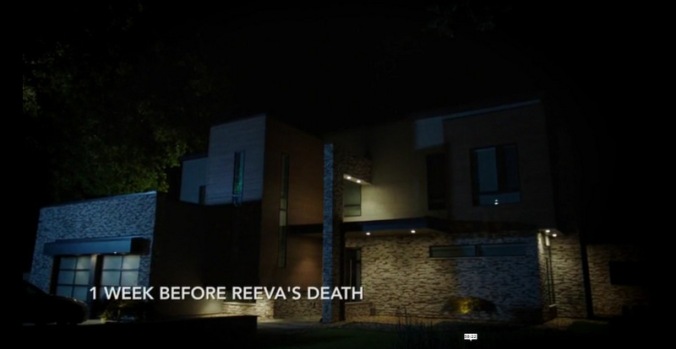No doubt about it, “Blade Runner Killer” is a confusing flick. It jumps around unnecessarily…or is there a reason it’s such a muddle? By Nick van der Leek
I’ve spent a few days meticulously analyzing the first film about the Pistorius case, premised on Reeva’s perspective. I’ve taken an interest because the 14 books Lisa and I co-researched and co-wrote between June 2014 and December 2017 follow exactly the same theme – Reeva. What was her perspective on her murder? What was this crime like for her? What did it look like from the inside, what did Oscar look like inside his home, and inside the cubicle?
Going through the 83 minute film, it soon became clear the timeline was not only muddled, but incorrect. Starting with the second slide, Reeva is presented in the kitchen, cooking dinner at 17:30. In fact she only arrived home that evening at 18:00, and Pistorius ten minutes later at 18:10.

To appreciate just how jumbled the plot is, have a look at the following screen-grabs – all of which are taken on the dozen or so occasions when the film time-stamps itself with a caption.
I’ve included the above slide in the timeline again for reasons of completeness.










- In this particular slide, the caption is undated and at the top for the first time. The incident here seems to depict three separate events. Reeva is dressed in black, the same way as she appeared at the Virgin Active Sports Awards on January 7th, 2013. However, Oscar’s jealousy and tantrum seems to be a conflation from at least ten days prior, at Darren Fresco’s engagement party. It was after this party that Reeva wrote her “unhappy and sad” message at 14:17 on Saturday, January 26th, 2013, complaining about being in a “double standard relationship”. The film also conflates the exit from the awards with the incident where Oscar drove so fast it frightened Reeva, and June ended up chastising him over the phone, while he was driving.





If it’s still not clear, around half the slides are out of order, inaccurate or both. “Trial Day 1” doesn’t make any sense, because the previous slide, “March 3, 2014,” was the first day of trial, so why say it twice?
Below is a list showing in bold and red what’s out of order, inaccurate or both.
- February 13th, 2013, 06:04
- February 13th, 2013, 17:30
- February 14th, 06:43
- February 13th, 2013, 14:16
- 5 months before Reeva’s death [inaccurate]
- New Year’s Eve – 6 weeks before Reeva’s death
- 1 Week before Reeva’s death
- Oscar’s trial, March 14th, 2014
- South African Sports Awards Party [undated, caption appears at the top for the first time][Actual Date Virgin Active Sport Industry Awards 2013 held at Emperors Palace on Feb. 7, 2013]
- 1 month before Reeva’s death.
- February 14th, 2013, 11:26
- Oscar’s Trial, March 3, 2014
- Trial Day 1 [March 3, 2014 – date not provided, but same as 12]
- Appeal Trial narrative provided [not including November/December 2017]
About half of the narrative, set out in this way, is taken out of the normal chronology.
When one colour-codes the narrative, it becomes even more obvious how out of order the narrative, but also how unnecessarily, out of order it is.

Yet when rearranged [see above] the plot fits together perfectly. So if you’re going to go to the trouble to set out a timeline, why not have a proper seamless, chronological narrative in the first place? Isn’t that why you have a timeline – to structure and properly explicate your story, especially when it’s a legal drama?
Overall, it seems as though the filmmaker’s went to a lot of effort to get the details right. Plenty of effort went into the special effects to show South African born Andreas Damm, who plays Oscar, walking on his stumps.
The film narrative also refers to and dramatizes the actual content of WhatsApps. They even got Reeva’s outfits at the awards ceremonies right, down to her hairstyle, his and her tattoos and even the tippex-like splodges on the back of Oscar’s head.

In the film, a message on Oscar’s phone from “Baby Shoes”, and Reeva intercepting it and confronting him about it, appears to be what triggers the conflagration, leading to Reeva’s murder.

Accents aside, I thought both actors nailed the emotional dynamic of the relationship for the first time.
So here’s a question. Why would you go to so much effort to get the details right, and then intentionally fuzz up your own film, fudging the chapter details, jumbling the flashbacks within the flashbacks, confusing and irritating your audience?
Why would you go to the trouble to set up a timeline, and then Rubik’s-cube it, effectively shooting yourself and your film in the foot?









